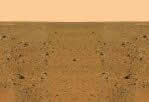| |
The
largest volcanoes in the solar system tower above the surface of
Mars. The Earth and Venus both have many volcanoes—as does
Jupiter's moon lo—but these are puny compared to those of Mars,
which are giants in both height and spread. Even though the largest,
Olympus Mons, stands 17 miles high—three times the height of
the Earth's tallest volcano, Mauna Loa, in Hawaii—it was known
only as a dot on the surface until the Mariner 9 space probe visited
in 1971. And Olympus Mons is just one of 20 huge volcanoes that
dominate the Martian landscape.
|
| Monsters
Of Fire |
The
surface of Mars bears witness to an active geological history.
Wind and water have scoured and sculpted the Martian crust, leaving
meandering river beds, broad deltas and smoothed-out rock formations
like those familiar to us on Earth. But the most spectacular relics
of Mars' past are its huge volcanoes—the biggest in the solar
system. Even though Mars is only a little more than half the size
of the Earth, these extinct giants dwarf any on our planet. So
why did Mars breed such monsters?
|
Despite
the dramatic evidence of eruptions on its surface. Mars' geology
has been much more stable than the Earth's. The thick Martian
crust stayed immobile above the geological "hot spots"
that fueled its volcanoes, and so while the planet's interior
was hot enough to drive lava up to the surface, the mountains
of lava and ash that piled up in eruption after eruption kept
growing.
|
The
same forces are building volcanoes on Earth today. But our planet's
crust is fractured into continent-sized plates that are constantly
on the move. Because of this, volcano-firing hot spots must find
new outlets for their lava every few million years. The Hawaiian
Island chain shows this phenomenon in action. The islands are
a line of mostly extinct volcanoes that map the progress of the
Pacific plate over a hot spot. The Earth's biggest volcano, Mauna
Loa, is simply the youngest of the chain to appear above sea level—which
is why it is at the end of the line, dominating the southern part
of the island of Hawaii.
|
| Evidence
from Orbit |
All
that we know of Mars 7 volcanoes has come from photographs taken
by orbiting spacecraft, starting with Mariner 9 in 1971. Since
then, the two Viking probes (1976) and the Mars Global Surveyor
(1997-9) have returned more detailed images that tell the life
histories of Mars' volcanoes. From studies of impact craters on
volcano slopes, astronomers have calculated that the oldest volcano
still visible on the surface rose up over 3 billion years ago
and the youngest was active only 30 million years ago. The oldest
type, called Patera, are shaped like upside-down saucers, rising
only a few miles above the surrounding terrain, and were probably
formed from a mixture of lava and ash. The youngest and tallest
are shield volcanoes—the same type as the Earth's Mauna Loa—with
gentle slopes spreading out over huge areas. The lava that made
these was relatively thin, and flowed huge distances before cooling
and solidifying. A third type of Martian volcano is the dome,
with steeper sides made from stickier lava or fewer eruptions.
|
But
not all volcanoes resemble the popular image of a cone-shaped
mountain topped by a smoking crater. Lava can also spread out
over a wide area, filling up valleys and submerging impact craters
to leave smooth plains. When Mars was young, eruptions covered
most of the planet's northern hemisphere in just this way—the
same process that gave our Moon its so-called "seas."
|
The
great days of Martian volcano-building are long gone. It must
have been a very different planet then, with massive outgassings
into the atmosphere along with the ejections of lava. But though
we may never see Olympus Mons blow its top again, there may be
small-scale volcanic activity still disturbing Mars' crust. Only
further exploration of the surface will tell.
|
|
|

|
|
|
|


| OLD
FAITHFUL |
| The
volcano Alba Patera may have been active for over 1.5 billion
years. |

| FIRST
HURDLE |
| The
base of Olympus Mons is surrounded by a cliff that rises to
a height of 3.7 miles, which is almost the height of Mount McKinley
in Alaska. |

| NIX
SNOW |
| Before
astronomers knew that Olympus Mons was a volcano, they named
the bright patch they could see on the planet Nix Olympica—"Snows
of Olympus." The "mw11 turned out to be clouds that
gather around the volcano's summit. |
|
|



